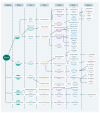Current Evidence on the Role of the Gut Microbiome in ADHD Pathophysiology and Therapeutic Implications
- PMID: 33467150
- PMCID: PMC7830868
- DOI: 10.3390/nu13010249
Current Evidence on the Role of the Gut Microbiome in ADHD Pathophysiology and Therapeutic Implications
Abstract
Studies suggest that the bidirectional relationship existent between the gut microbiome (GM) and the central nervous system (CNS), or so-called the microbiome-gut-brain axis (MGBA), is involved in diverse neuropsychiatric diseases in children and adults. In pediatric age, most studies have focused on patients with autism. However, evidence of the role played by the MGBA in attention deficit/hyperactivity disorder (ADHD), the most common neurodevelopmental disorder in childhood, is still scanty and heterogeneous. This review aims to provide the current evidence on the functioning of the MGBA in pediatric patients with ADHD and the specific role of omega-3 polyunsaturated fatty acids (ω-3 PUFAs) in this interaction, as well as the potential of the GM as a therapeutic target for ADHD. We will explore: (1) the diverse communication pathways between the GM and the CNS; (2) changes in the GM composition in children and adolescents with ADHD and association with ADHD pathophysiology; (3) influence of the GM on the ω-3 PUFA imbalance characteristically found in ADHD; (4) interaction between the GM and circadian rhythm regulation, as sleep disorders are frequently comorbid with ADHD; (5) finally, we will evaluate the most recent studies on the use of probiotics in pediatric patients with ADHD.
Keywords: ADHD; circadian rhythm; fatty acids; gastrointestinal microbiome; omega-3; probiotics.
Conflict of interest statement
The authors declare no conflict of interest.
Figures



References
Publication types
MeSH terms
Substances
LinkOut - more resources
Full Text Sources
Other Literature Sources
Medical

